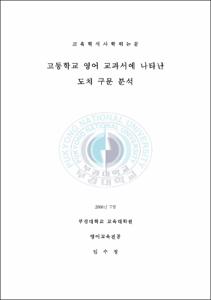고등학교 영어 교과서에 나타난 도치 구문 분석
- Alternative Title
- An Analysis of English Inversions in High School English Textbooks
- Abstract
- The purpose of this study is to classify the types of English inversions and to explain the causes of English inversions in High School English textbooks.
Before analysing the textbooks, the definition and types of inversion constructions are described. English inversions are divided into two types: subject-verb inversions(SVI) and subject-auxiliary inversions(SAI). SVI, according to the types of preposed constituents, can be classified into locative PP's and adverbials, directional PP's and adverbials, temporal and manner adverbials, abstract PP's, predicate nominals and objects, and adjectivals and participles. SAI can be classified into preposed negative constituents, preposed so-phrases, comparatives with as/than, and subjunctive.
Also, the causes of inversions are explained by sentence-internal and sentence-external factors. The sentence-internal factors are the principle of relative weight, the definiteness of preposed constituents or the principle of cohesion. The sentence-external factors are introduction or setting of background, emphasis, topic continuity or text strategies.
Based on these, inverted sentences are collected from the textbooks. The collected sentences are 192; SVI is 66% and SAI 34%. All types of SVI described above are found except directional PP's and adverbials, manner adverbials, and objects. Among these, the most frequently appeared one is locative PP's and adverbials(72%). Especially, the verbs of this type are more various; stand, live, dangle, dwell, lie, etc. Among the types of SAI, preposed negative constituents(51%), preposed so phrases(32%), and subjunctive(17%) are found, but comparatives with as/than and so-Adj./Adv. are not. Moreover, this study, through the sentences from the textbooks, showed that how the inversion is triggered.
In short, in High School English textbooks, SVI are about twice more than SAI. And the inversions are triggered by both sentence-internal and sentence-external factors. Therefore, in classrooms, it is recommended that the inverted sentences be taught not only in sentence level but also discourse level.
- Issued Date
- 2008
- Awarded Date
- 2008. 8
- Type
- Dissertation
- Keyword
- 도치 구문 English Inversions 형용사
- Publisher
- 부경대학교 교육대학원
- Alternative Author(s)
- Im, Sue jeong
- Affiliation
- 부경대학교 교육대학원
- Department
- 교육대학원 영어교육전공
- Advisor
- 전춘배
- Table Of Contents
- Ⅰ 서론 = 1
1.1 연구의 필요성과 목적 = 1
1.2 연구의 구성과 제한점 = 2
Ⅱ 이론적 배경 = 4
2.1 도치 구문의 정의 = 4
2.2 도치 구문의 유형 = 5
2.2.1 주어-본동사 도치 = 5
2.2.2 주어-조동사 도치 = 10
2.3 도치의 원인 = 13
2.3.1 문장 내적 요인 = 14
2.3.2 문장 외적 요인 = 17
Ⅲ 자료 분석 및 논의 = 22
3.1 분석 대상 및 방법 = 22
3.2 분석 결과 = 24
3.2.1 주어-본동사 도치 = 25
3.2.1.1 장소 부사어구 전치문 = 26
3.2.1.2 시간 부사어구 전치문 = 28
3.2.1.3 형용사 및 분사 전치문 = 30
3.2.1.4 보어 명사 전치문 = 32
3.2.1.5 추상적인 전치사구 전치문 = 33
3.2.2 주어-조동사 도치 = 37
3.2.2.1 부정 요소 전치문 = 38
3.2.2.2 So 전치문 = 42
3.2.2.3 조건ㆍ양보 종속절 = 43
Ⅳ 결론 = 46
교과서 분석 자료 = 48
참고 문헌 = 49
- Degree
- Master
- Files in This Item:
-
-
Download
 고등학교 영어 교과서에 나타난 도치 구문 분석.pdf
기타 데이터 / 438 kB / Adobe PDF
고등학교 영어 교과서에 나타난 도치 구문 분석.pdf
기타 데이터 / 438 kB / Adobe PDF
-
Items in Repository are protected by copyright, with all rights reserved, unless otherwise indicated.